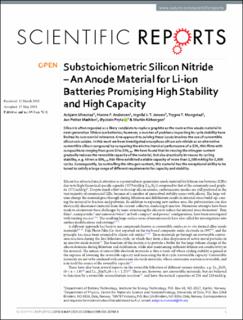| dc.contributor.author | Ulvestad, Asbjørn | |
| dc.contributor.author | Andersen, Hanne Flåten | |
| dc.contributor.author | Jensen, Ingvild Julie Thue | |
| dc.contributor.author | Mongstad, Trygve | |
| dc.contributor.author | Mæhlen, Jan Petter | |
| dc.contributor.author | Prytz, Øystein | |
| dc.contributor.author | Kirkengen, Martin | |
| dc.date.accessioned | 2020-11-30T13:28:29Z | |
| dc.date.available | 2020-11-30T13:28:29Z | |
| dc.date.created | 2018-06-08T06:44:18Z | |
| dc.date.issued | 2018 | |
| dc.identifier.issn | 2045-2322 | |
| dc.identifier.uri | https://hdl.handle.net/11250/2690252 | |
| dc.description.abstract | Silicon is often regarded as a likely candidate to replace graphite as the main active anode material in next-generation lithium ion batteries; however, a number of problems impacting its cycle stability have limited its commercial relevance. One approach to solving these issues involves the use of convertible silicon sub-oxides. In this work we have investigated amorphous silicon sub-nitride as an alternative convertible silicon compound by comparing the electrochemical performance of a-SiNx thin films with compositions ranging from pure Si to SiN0.89. We have found that increasing the nitrogen content gradually reduces the reversible capacity of the material, but also drastically increases its cycling stability, e.g. 40 nm a-SiN0.79 thin films exhibited a stable capacity of more than 1,500 mAh/g for 2,000 cycles. Consequently, by controlling the nitrogen content, this material has the exceptional ability to be tuned to satisfy a large range of different requirements for capacity and stability. | en_US |
| dc.language.iso | eng | en_US |
| dc.publisher | Nature Publishing Group | en_US |
| dc.relation.uri | https://www.nature.com/articles/s41598-018-26769-8 | |
| dc.rights | Navngivelse 4.0 Internasjonal | * |
| dc.rights.uri | http://creativecommons.org/licenses/by/4.0/deed.no | * |
| dc.subject | Silicon | en_US |
| dc.subject | Anode | en_US |
| dc.title | Substoichiometric Silicon Nitride – An Anode Material for Li-ion Batteries Promising High Stability and High Capacity | en_US |
| dc.title.alternative | Substoichiometric Silicon Nitride – An Anode Material for Li-ion Batteries Promising High Stability and High Capacity | en_US |
| dc.type | Journal article | en_US |
| dc.type | Peer reviewed | en_US |
| dc.description.version | publishedVersion | en_US |
| dc.rights.holder | Open Access This article is licensed under a Creative Commons Attribution 4.0 International
License, which permits use, sharing, adaptation, distribution and reproduction in any medium or
format, as long as you give appropriate credit to the original author(s) and the source, provide a link to the Creative Commons license, and indicate if changes were made. Te images or other third party material in this
article are included in the article’s Creative Commons license, unless indicated otherwise in a credit line to the
material. If material is not included in the article’s Creative Commons license and your intended use is not permitted by statutory regulation or exceeds the permitted use, you will need to obtain permission directly from the
copyright holder. To view a copy of this license, visit http://creativecommons.org/licenses/by/4.0/. | en_US |
| dc.source.pagenumber | 13 | en_US |
| dc.source.volume | 8 | en_US |
| dc.source.journal | Scientific Reports | en_US |
| dc.identifier.doi | 10.1038/s41598-018-26769-8 | |
| dc.identifier.cristin | 1589867 | |
| dc.relation.project | Norges forskningsråd: 257653 | en_US |
| dc.relation.project | Norges forskningsråd: 280885 | en_US |
| dc.relation.project | Norges forskningsråd: 197405 | en_US |
| dc.source.articlenumber | 8634 | en_US |
| cristin.unitcode | 7401,80,0,0 | |
| cristin.unitname | SINTEF Materialer og kjemi | |
| cristin.ispublished | true | |
| cristin.fulltext | original | |
| cristin.qualitycode | 1 | |

